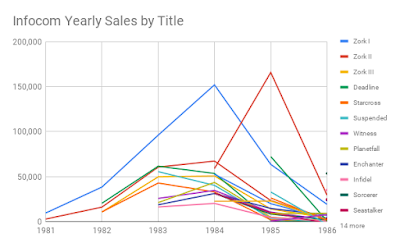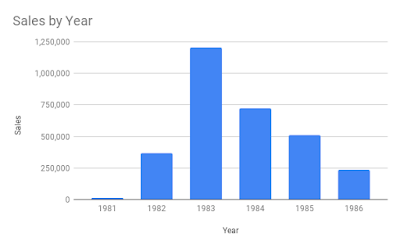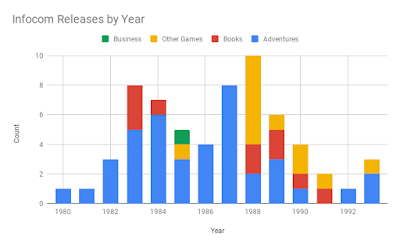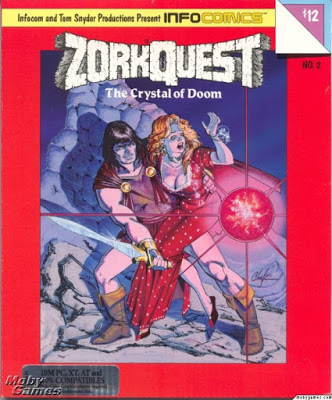From The Adventure Gamer
Written by Joe Pranevich
On June 13, 1986, Infocom ended, but our story does not. That is the day that Activision officially acquired Infocom. The team had fun with the event, even hosting a mock (Jewish!) wedding for Activision CEO Jim Levy and Infocom CEO Joel Berez. This was 18 years before same-sex marriage was legal in Massachusetts, otherwise they might have been in trouble! Infocom had made tremendous games, but they were no longer the successful upstart they once were. Depending on your point of view, Activision’s purchase either kept the adventure ball rolling for a few more years or ensured its eventual downfall.
Rather than doing a regular check-in post, I hope you will humor me as we look at Infocom’s situation both immediately before and after the purchase. This analysis will be based on sales data and other information that has leaked out in the three decades since Infocom was a running concern. There will be charts! We’ll also briefly recap 1985 and the beginning of 1986 games before looking towards the future. What happens to our Infocom marathon once Infocom is no longer its own company? Does this mean I need to play Activision’s Murder on the Mississippi (1985) and Portal (1986)? No, but there are still more games in front of us than behind.
If you were expecting a Consulting Detective post today, I am sorry to disappoint. We will continue our exploration of the Pilfered Paintings shortly, but for my birthday I gave myself permission to make charts instead. What could be a better birthday present? I hope you enjoy this brief return to our Infocom Marathon which I hope to resume properly in a few weeks.
As the strange newlyweds looked each other in the eye on that fateful June morning, I like to think that Joel had just two words that he was dying to say to his new beau, two words that would tell his new partner exactly what he meant to him. In my head, that meeting could only have ended one way, “Hello… sailor.”
 |
| They were charging people for adware! |
The Difficult Truth
Over the years, commentators have blamed Infocom’s demise on the iceberg that was Cornerstone development or the graphical overreach that was Fooblitzky. Those releases were failures, even colossal ones, and they both contributed to the premature end of Infocom as an independent company. And yet, here’s the big secret: I don’t think they had a choice. Using sales data that has leaked from the company since its closure, it seems clear that by 1984 Infocom knew they were up a creek. They scored one lucky break with Hitchhiker’s Guide and that bought they time and acclaim to land a bigger partnership, but that alone could not have cut it. If Infocom wanted to survive, they needed to get into different markets. They had to experiment because despite producing more than a dozen fantastic titles, they weren’t moving the needle the way that it had to be moved for them to have long term viability. We do not know today which games were “profitable” because they took different amounts of time and energy to make each one, but even without knowing their break-even point, the sales data shows something was amiss.
Infocom had some great successes. The hallmark of a title being a “success” in this era was often considered 100,000 units sold. Despite producing great games, only five titles met that criteria prior to the purchase: Zork I through III, Deadline, and Hitchhiker’s Guide. Suspended managed 99k units sold, so it could be an honorary member of that club. Except for Hitchhiker, those are all titles very early in the run. (Two more titles hit that goal under Activision: Wishbringer and Leather Goddesses. We’ll cover that in a future post.)
Even though they had a handful of successes, the truth is that Infocom only survived as long as they did because of Zork.
 |
| Two of these lines seem different than the others. |
Zork I: The Great Underground Cash Cow
There is something different about the first Zork game. For reasons that are nearly inexplicable today, it captured the public’s eye at a critical moment in gaming history and held on to it. For years, new gamers discovered and fell in love with Zork, while experienced gamers bought new copies as they purchased new computers. Zork was Infocom’s best selling title in 1981, 1982, 1983, and 1984, not just by a little but by a lot. Despite taking swings at sequels, science fiction, mysteries, comedies, and many others, Infocom saw each one surpassed in turn by a five-year out-of-date juggernaut. Zork I actually increased in sales every year until 1984. It sold 152K units in that year alone! Of course, we can’t say whether these were bargain bin vs original full price, but it is a tremendous number of copies.
Let me highlight this fact for you because it is critical to the failure of Infocom:
20% of every title Infocom ever sold was a copy of Zork I.
If you include the two direct sequels, that total comes to 34%. What must it have felt like in a forward-facing company like Infocom, to take swing after swing at success… only to never once recapture the genie in the bottle that was their very first product. Even worse, it was a product created on a lark while their founders were still in college! Every new Implementor, every new revision to the engine, and every investment on play-testing and they still could not deliver a game that captured the imagination like a little house in the forest with a boarded-up front door. This wasn’t sustainable and the management knew it; Infocom needed another hit in order to stay relevant. In 1984, they managed just that with their release of Hitchhiker’s Guide, but it was too little and too late.
 |
| This is titles shipped rather than dollars, but not a good sign. |
Declining Unit Sales
Even with Hitchhiker’s Guide sales through the roof, Infocom could not effectively respond to a weakening market. Too many new companies were producing too many new games, some of which were replacing quaint text adventures as the “must have” titles on new systems. A lot has been written about the Infocom pattern of having a large back-catalog: Infocom titles remained viable on the shelf of your neighborhood computer stores for years, making them sell more like books than the games of the era. This pattern was weakening by 1984 and by 1986 the company couldn’t move as many units as they had four years prior.
Given all of that, can we blame Infocom for their desperate (and misguided) attempts to branch out? Cornerstone cost too much to build, ran too slowly, and was poorly-adapted for the PC era, but that is the fault of the project management rather than a bad idea from jump. Similarly, experiments with graphical games must have seemed like a logical necessity. They chose a terrible way to do it, a least-common-denominator graphics engine that was far too slow for action games, but the idea isn’t wrong. Infocom didn’t fail to identify that they needed to do something else, they just absolutely failed to understand their new markets or build to them properly. The far-sighted among them realized that they could not win by making more text adventures. Even their best new games (many of which more fun than Zork I) could not get enough attention in the market to be viable. Add into this other boneheaded decisions such as wasting far too much money on rent at their new corporate headquarters, and failure was inevitable.
This declining pattern would continue under Activision, as we shall soon see. They pushed the Infocom team to produce more games faster, to offset the declining sales for each title by simply having a lot more of them. They ceased back-catalog sales. This would not prove to be a successful strategy either, but we will get to that part of the story in time.
I want to be careful here to stress that I am talking about declining unit sales, but somehow the top-line numbers for 1985 still looked pretty good. That year, Infocom reported a 15% increase from sales the previous fiscal year. My presumption is that the higher cost of Cornerstone offset the smaller sales figures, but this paltry increase (and the last increase they would ever show) was nowhere near enough to recoup the high development and marketing costs that were lost.
 |
| Activision pushed Infocom hard, but it was not enough. |
The Sale
While I could wax poetic about the terms of the sale and how the staff felt about it, our friend the Digital Antiquarian has already done a better job of this than I am likely to do thanks to his research and interviews. You can read his explanation here, but let me provide my own views on the big points.
First and foremost, by 1985 Infocom was getting desperate. With their declining sales and poor strategic thinking, the company was amassing significant debt and had little to show for it. They had previously been courted for a merger by Simon and Schuster, but that deal was long off the table. Infocom CEO Al Vezza hoped to be acquired by a company like Lotus, but there was no interest. The dealmaking began that December with the first informal meetings between Jim Levy, CEO of Activision, and Infocom. This happened almost simultaneously with the layoff of the remaining business products group, cementing Infocom (in Activision’s eyes as well as the rest of the world) as a gaming-only company. This was followed by the resignations of Marc Blank and Joel Berez. (But don’t worry: Marc will be back for Border Zone in 1987.)
In February, Activision and Infocom signed an intent agreement; it was followed by the real deal in June. In just seven months from idea to execution, Infocom was “saved” from their imminent demise and given a new set of opportunities and a new set of promises. By all accounts, the next period under Jim Levy’s management was a positive one even as the sales didn’t precisely flow in. We’ll get to what life was like under Activision in the next yearly wrap-up.
Looking Back
Since our last check-in, we’ve looked at five additional games (Wishbringer, A Mind Forever Voyaging, Fooblitzky, Spellbreaker, and Ballyhoo), plus Cornerstone. It’s been months since I played Ballyhoo, but I am eager to get back into playing some text adventures. If you are coming late to this party, here’s an index of all of the games we have played so far:
- Dungeon – (1) (2) (3) (4) (5) (6) (7) (8)
- Zork I – (1)
- Zork II – (1) (2)
- Deadline – (Ilmari) (Joe)
- Zork III – (1) (2)
- Starcross – (1) (2) (3)
- Suspended – (1)
- The Witness – (Ilmari) (Joe)
- Planetfall – (1) (2) (3)
- Enchanter – (1) (2) (3) (4)
- Infidel – (1) (2) (3)
- 1983 Books
- Sorcerer – (1) (2) (3) (4) (5)
- Seastalker – (1) (2)
- Tutorial Game – (1)
- Cutthroats – (1) (2) (3)
- Hitchhiker’s Guide – (B) (1) (2) (3) (4) (5)
- Suspect (Ilmari) (Joe)
- 1984 Books and Updated Manuals
- Cornerstone – (1)
- Wishbringer – (B) (1) (2) (3)
- A Mind Forever Voyaging – (1) (2) (3) (4)
- Fooblitzky – (1) (Video) (Interview)
- Spellbreaker – (1) (2) (3) (4) (5) (6)
- Ballyhoo – (1) (2) (3)
Wishbringer has become, without a doubt, my favorite game to play so far in this marathon. It is so whimsical, lovingly done, and beautifully connected to the Zork saga. If you play only one Infocom game in your life, you should play Zork I… but Wishbringer should be in everyone’s top three, at least so far. I’m not sure if the ratings exactly align with my feelings, but it is still a bright spot in my memory. Maybe as I get further through, I’ll assemble my final “Top 10” list, but Wishbringer has to be close to the top tier.
Spellbreaker and Ballyhoo, while good, feel like the Infocom crew put their fears on paper rather than making the best possible games. Both of these titles are about endings and times changing, topics on the teams’ minds when they were playing, but the melancholy has not aged as well as the other titles. Spellbreaker is nearly impossibly hard, even by earlier Infocom standards, although bringing our Enchanter’s story to a close was more fulfilling than the ending of the first Zork trilogy.
AMFV still just feels like an art piece and a product of the 1980s rather than a timeless classic. I have absolutely no desire to ever pick it up again.
Although technically part of the previous batch of games, I am still impressed by the appeal (even today) of the Hitchhiker’s Guide games. As of September 2019, the original “banned” Hitchhiker’s game is the #3 most read post on the site. The introduction to the Infocom game is #8. I doubt we’ll see many more games in our marathon with such crossover appeal! Our number one post is, appropriately enough, from Secret of Monkey Island.
 |
| Infocom’s least sold game. |
The Long Road Ahead
With Infocom resigned to the dustbin of history, you’d think we’d be close to the end. Absolutely not! In fact, we have just about as much ahead of us as behind, assuming that we get to it all. The Activision years were busy years, even as the company struggled and Infocom branched out. These years also brought a continuum of collaborations to Infocom’s world, ranging from games as before where Infocom was the sole developer to games where they were just a label, and every possible combination in between. I’m not completely sure of the history of each of our upcoming games yet, but I am looking forward to researching them as we get there.
Here is a quick census of what we have left. Not all of these will get the full treatment; some may warrant only a bonus post or a slot in a yearly wrap-up:
- The so-called Infocom “canon” is 35 games from Zork I to Arthur, even though a couple of the later games were developed by third parties. Of these, we have sixteen games left so we have made it just shy of half way. Only three were in the original Zork Marathon plan, now all but abandoned: Stationfall (1987), Beyond Zork (1987), and Zork Zero (1988).
- There are four “Infocomic” releases, two each that tied into to the Zork and Leather Goddesses series. I’ve barely looked at these and have no idea how much “game” is in each one. According to the data that I have, ZorkQuest II has the dubious distinction of being the worst-selling Infocom title ever at less than 4,000 copies. These were developed in partnership with Tom Snyder Productions.
- Other than Beyond Zork, there are two more RPG/text-adventure hybrids that Infocom worked on to different extents: Quarterstaff and Circuit’s Edge. We played the latter as “Guest Game 1” before the current format of the blog. Infocom also has their names on several other RPGs including two Battletech games as well as Tombs and Treasure for the NES.
- Two graphical games, Leather Goddesses II and Simon the Sorcerer; we covered the first already. Infocom was consulted (how much, I am not clear) on the first Simon game, but was not involved in any of the sequels.
- A promotional release of Mini-Zork I for the Commodore 64 many years after the C64 was a dominant platform. Why?
- Six Infocom novels that take place in the Zork and Planetfall universes.
- Four Japanese versions of Infocom games (Zork I, Planetfall, Moonmist, and Enchanter) which have added graphics. Another Japanese “Infocom” release, Nigel Mancell’s F1 Challenge for the Famicom, defies explanation.
- And finally: Return to Zork, ending the marathon in 1993. It’s possible this may get played before some of the above games, but we’ll be pushing RtZ out to as late in 1993 as practical so that I can play as many of these as I can.
The games immediately in our future are fairly “normal” and it will be a while before desperation set in and we get the more bonkers choices. Thanks to Activision cracking the whip, 1986 and 1987 will see more games produced faster than ever before. Can Infocom keep up the quality with less development time and less QA? We’re going to find out soon.
We’ll start Trinity (1986) right after Consulting Detective, but I have one more bonus post before then: Crash Dive! (1984). This is Brian Moriarty’s second game and that last that he made before joining Infocom. His first game was one of the worst we ever reviewed, yet his Infocom debut was nothing short of amazing. Where will this middle work fall on the scale? I’m looking forward to finding out… just as soon as I figure out who stole these paintings. See you soon!
Original URL: https://advgamer.blogspot.com/2019/09/zork-marathon-selling-house-that-zork.html


